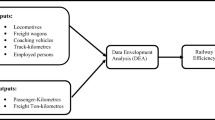Abstract
We estimate a factor requirement frontier for European railways using a panel data approach in which technical efficiency is assumed to be endogeneously determined. This approach has two main outcomes. On one hand, it allows the identification of factors influencing technical efficiency, and on the other hand, it allows the estimation of alternative efficiency indicators free of these influences. In the case under study, a particular attention is devoted to an autonomy indicator representing the managerial freedom, with respect to public authorities, experienced by firms, that appears to be positively correlated with technical efficiency.
Similar content being viewed by others
References
Aigner, D.J., C.A.K. Lovell, and P. Schmidt. (1977). “Formulation and estimation of stochastic frontier production function models.” Journal of Econometrics 6, pp. 21–37.
Amemiya, T. and T.E. MaCurdy. (1986). “Instrumental-variable estimation of an error-components model.” Econometrica 54, pp. 869–880.
Battese, G.E. and T.J. Coelli (1988). “Prediction of firm-level technical efficiencies with a generalized frontier production function and panel data.” Journal of Econometrics 38, pp. 387–399.
Battese, G.E. and T.J. Coelli. (1991). “Frontier production functions, technical efficiency and panel data: with application to paddy farmers in India.” Department of Econometrics, University of New England, Australia.
Bjurek, H., L. Hjalmarsson, and F.R. Forsund. (1990). “Parametric and nonparametric estimation of efficiency in service production: a comparison.” Frontier analysis, parametric and non parametric approaches, edited by A.Y. Lewin and C.A. Knox Lovell in Journal of Econometrics Annals 1990–4, 46-1/2, pp. 213–228.
Breusch, T.S., G.E. Mizon, and P. Schmidt. (1989). “Efficient estimation using panel data.” Econometrica 57, pp. 695–700.
Caves, D.W., L.R. Christensen, and J.A. Swanson. (1981). “Productivity growth, scale economies and capacity utilization in U.S. railroads, 1955–1974.” The American Economic Review 71, pp. 994–1002.
Coelli, T.J. (1989). “Estimation of frontier production functions: A guide to the computer program ‘Frontier’.” Working Papers in Econometrics and Applied Statistics, University of New England, Australia, 34..
Cornwell, C.P., P. Schmidt, and R.C. Sickles. (1990). “Production Frontiers with Cross-Sectional and Time-Series Variation in Efficiency Levels.” Frontier analysis, parametric and non parametric approaches, edited by A.Y. Lewin and C.A. Knox Lovell in Journal of Econometrics Annals 1990–4, 46-1/2, pp. 185–200.
Deprins, D. and L. Simar. (1988). “Mesure d'efficacité des résaux de chemins de fer.” In CORE (ed.) Gestion de l'économie et de l'entreprise: l'approche quantitative, Bruxelles, DeBoek-Wesmael, pp. 321–344.
Diewert, W.E. (1973). “Functional forms for profit and transformation functions.” Journal of Economic Theory 6, pp. 284–316.
Diewert, W.E. (1974). “Functional forms for revenue and factor requirements functions.” International Economic Review 15–1, pp. 119–130.
Gathon, H.J. (1991). “La performance des chemins de fer européens: Gestion et autonomie.” Ph.D. thesis, Department of Economies, University of Liège.
Greene, W.H. (1980). “Maximum likelihood estimation of econometric frontier functions.” Journal of Econometrics 13, pp. 27–56.
Hausman, J.A. and W.E. Taylor. (1981). “Panel data and unobservable individual effects.” Econometrica 49, pp. 1377–1398.
Jondrow, J., C.A.K. Lovell, I.S. Materov, and P. Schmidt. (1982). “On the estimation of technical inefficiency in the stochastic frontier production function model.” Journal of Econometrics 19, pp. 233–238.
Klein, L.R. (1953). A textbook of econometrics. New York: Row Peterson.
Kumbhakar, S.C. (1988). “Production frontiers, panel data and time-varying technical inefficiency.” Frontier analysis, parametric and non parametric approaches, edited by A.Y. Lewin and C.A. Knox Lovell inJournal of Econometrics Annals 1990–4, 46-1/2, pp. 201–212.
Meeusen, W. and J. van den Broeck (1977). “Efficiency estimation from Cobb-Douglas production functions with composed error.” International Economic Review 18, pp. 435–44.
Mundlak, Y. (1961). “Empirical production function free of management bias.” Journal of Farm Economics 43, pp. 44–56.
Mundlak, Y. (1978). “On the pooling of time-series and cross-section data.” Econometrica 49, pp. 69–86.
Nash, C. (1985). “European railways comparisons—What can we learn?” In K.J. Bulton and D.E. Pitfield (eds.) International Railway Economics. London: Gower House.
Nishimizu, M. and J.M. Page. (1982). “Total factor productivity growth, technological progress, and technical efficiency change: dimensions of productivity change in Yugoslavia, 1967–1978.” Economic Journal 92, pp. 920–936.
Perelman, S. and P. Pestieau. (1988). “Technical performance in public enterprises, a comparative study of railways and postal services.” European Economic Review 32, pp. 432–441.
Schmidt, P. and R.C. Sickles. (1984). “Production frontiers and panel data.” Journal of Business and Economics Statistics 2, pp. 367–374.
UIC (1961–1988). International Railway Statistics. Statistics of individual railways, Paris.
Wallace, T.D. and A. Hussein. (1969). “The use of error components models in combining cross-section with time-series data.” Econometrica 37, pp. 55–72.
Wang Chiang, S.J. and A.F. Friedlander. (1984). “Output aggregation, network effects, and the measurement of trucking technology.” Review of Economics and Statistics 20, pp. 267–276.
Author information
Authors and Affiliations
Rights and permissions
About this article
Cite this article
Gathon, HJ., Perelman, S. Measuring technical efficiency in European railways: A panel data approach. J Prod Anal 3, 135–151 (1992). https://doi.org/10.1007/BF00158773
Issue Date:
DOI: https://doi.org/10.1007/BF00158773




